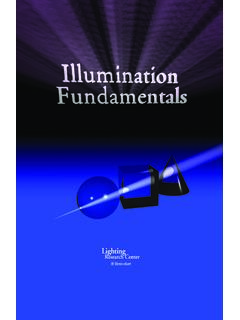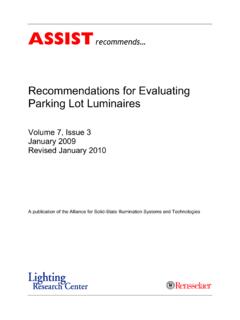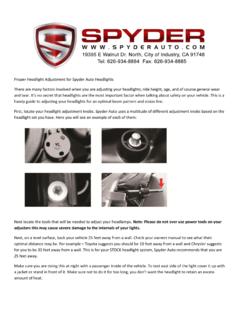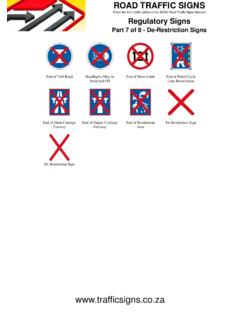Transcription of Seeing With Headlights
1 Seeing With HeadlightsGene Farber, ConsultantNHTSA Workshop on Headlamp Safety MetricsWashington, DC July 13, 2004, 2 You can t see worth a damn atnight (Paul Olson) Day/night illumination ratio: 105 Pedestrian visibility distancenight: 150 - 250 feet day: 1000 s of feet Distance required to respond and stop from 55 mph: 265 feet3 Night drivers have little time to respond to obstacles Best data on PRT gives means of to seconds 85thpercentile values of to seconds. Glance durations can range from to seconds (IP tasks, mirror looks, looks to the side, etc.) Effective response latency of or more sec4 Over-driving Headlights Headlamps provide enough light for primary driving task of lane-keeping Low visibility obstacles are extremely rare and thus not expected Driver s (and pedestrians) over-estimate visibility Result.
2 We over-drive Headlights WRTobstacles but not Headlamp Seeing distance program developed at Ford Based on Blackwell data and formulations Estimates Seeing distance as influenced by human, environmental and lighting parameters Validated in early 70 s in field studies6 Pedestrian, tallTarget type, size Normal Alertness35, 50thPercentileDriver age & contrast sensitivityNoneGlare from opposing carsCorrectHeadlamp aimTwo feet above groundHeadlamp heightTaurus low beamsHeadlampsBase Conditions780%Windshield transmittanceStraight and levelGeometryTwo 12-foot lanesRoad FLAmbient illumination6%Pavement reflectance8%Target reflectance2 feet right of right lane edgeTarget locationBase Conditions8 Distance from Target => Luminance required for detection Luminance Luminance of target Threshold detection point 9 Headlamp Intensity Seeing Distance (feet) Headlamp Intensity (%)
3 50 100 150 200 10 Target Location Seeing Distance (feet) Target Location 0 50 100 150 Right Edgeline+ 6 feet Right Edgeline+ 2 feet Right Edgeline Center of Right Lane On Road Centerline Center of Left Lane Left Edge of Left Lane 11 Target Size Seeing Distance (feet) Target SizePedestrian Height (feet)
4 100 125 150 175 12 Driver Age Seeing Distance (feet) Driver Age (ears)50 100 150 200 20 30 35 40 50 60 70 13 Contrast Sensitivity Seeing Distance (feet) Contrast Sensitivity (Percentile)50 100 150 200 5th 15th 50th 85th 95th 14 Target Reflectance Seeing Distance (feet)
5 % 0 100 200 300 15 Headlamp Misaim Seeing Distance (feet) Vertical Misaim (Degrees) 50 100 150 200 + + 16 Glare Seeing Distance (feet) Glare Car Distance (feet) 140 160 180 No Glare 1000 feet 500 feet 300 feet 200 feet 100 feet 50 feet 17 Opposing Glare at 300 Feet Seeing Distance (feet)
6 Lamp Condition 50 150 200 250 Low Beam No Glare Low Beam Glare High Beam No Glare High Beam Glare 18 Opposing Glare Road Width Effects Seeing Distance (feet) Lamp Condition 100 150 200 250 Low Beam 2-lane Road Low Beams 4-lane Road High Beam 2-lane Road High Beam 4-lane Road 19 Effect of Glare Source Distance050100150200250040080012001600 Glare Source Distance (ft) Seeing Distance (ft)Lo/LoHi/Hi20 Closing thoughts High beams are better than low beams for pedestrian detection (but not all thatmuch better).
7 High beam glare is much worse than low beam glare. Even with high beams, drivers have little time to respond to thoughts Need a systems approach for evaluation Need to consider behavioral factors. Need to consider driver comfort: Pedestrian at risk extremely rare eventAlways-on high beams a constantirritation Alternatives:Better signaling and markingSmarter Headlights





